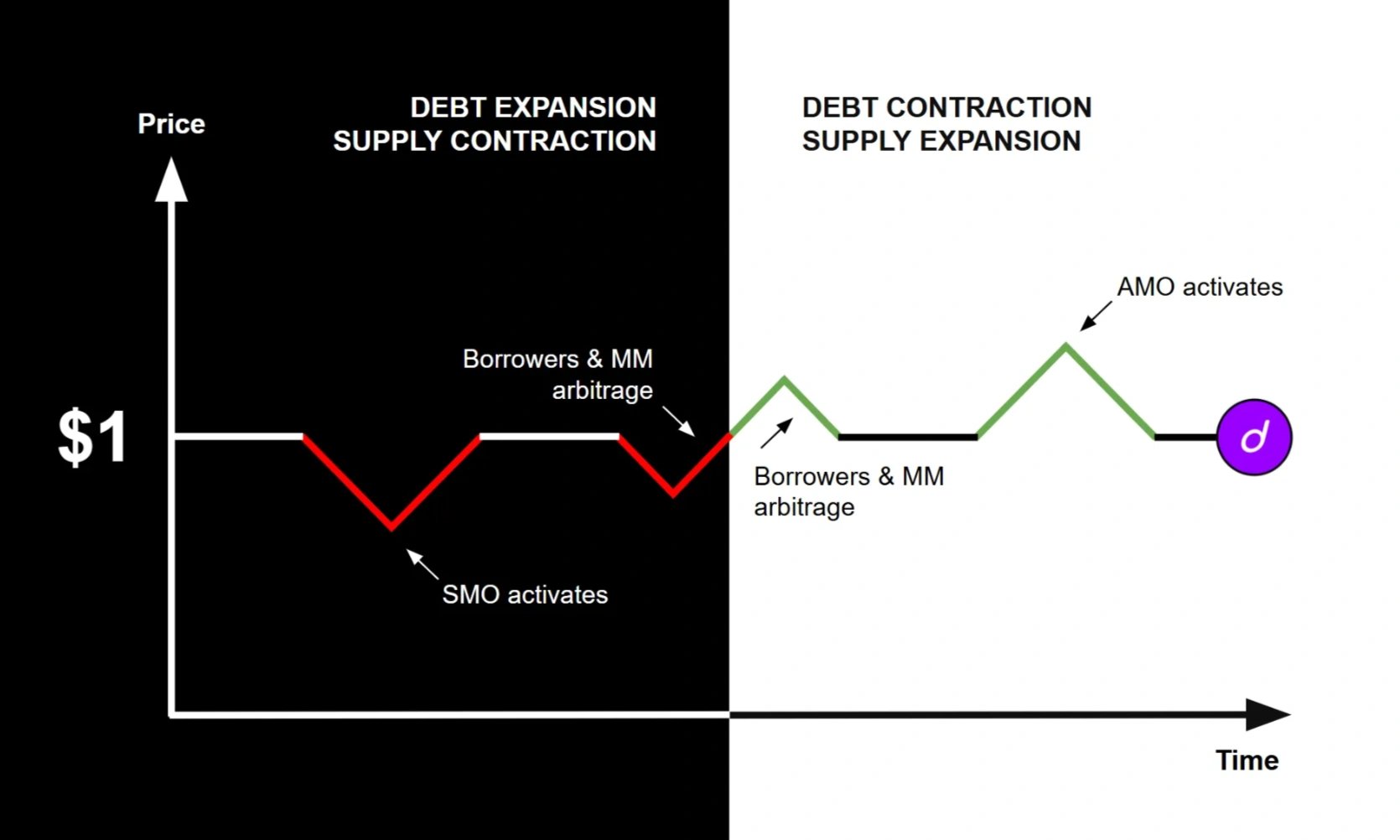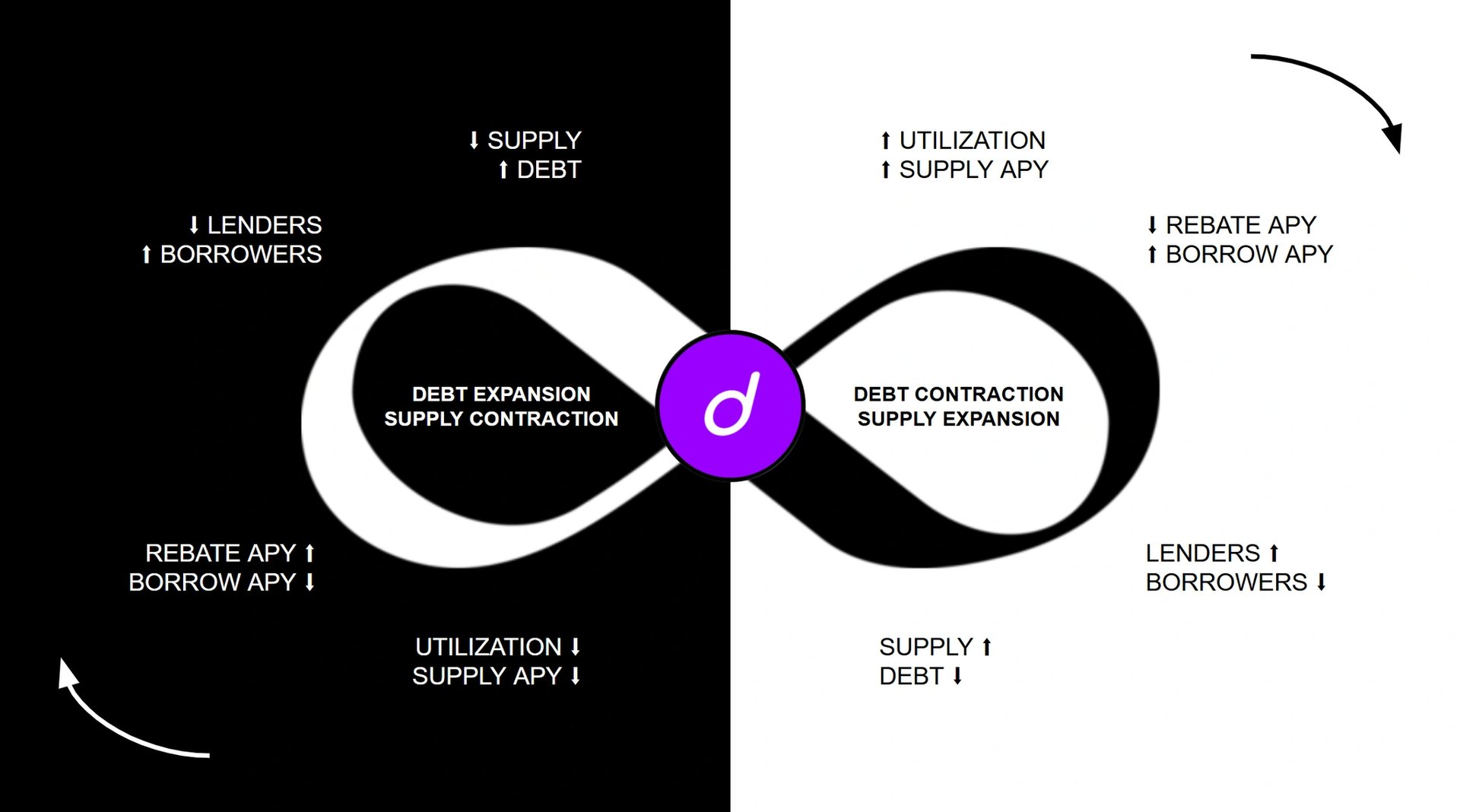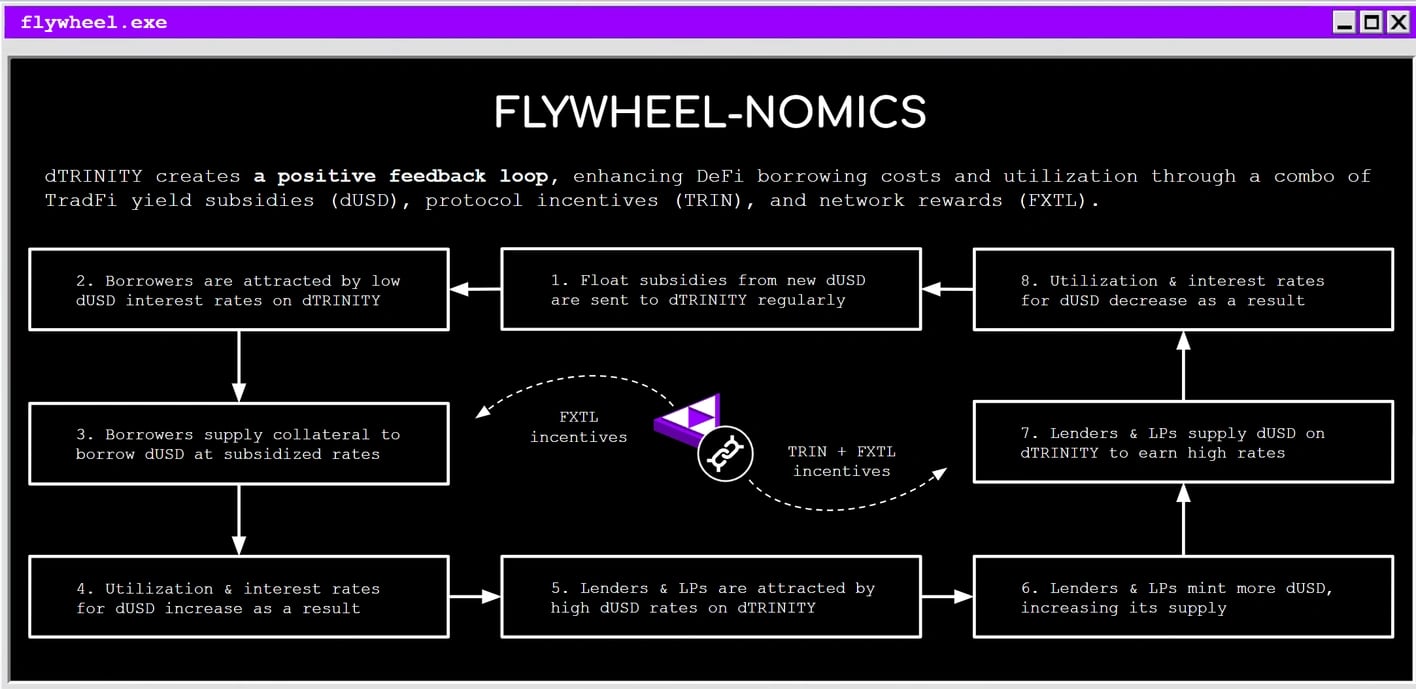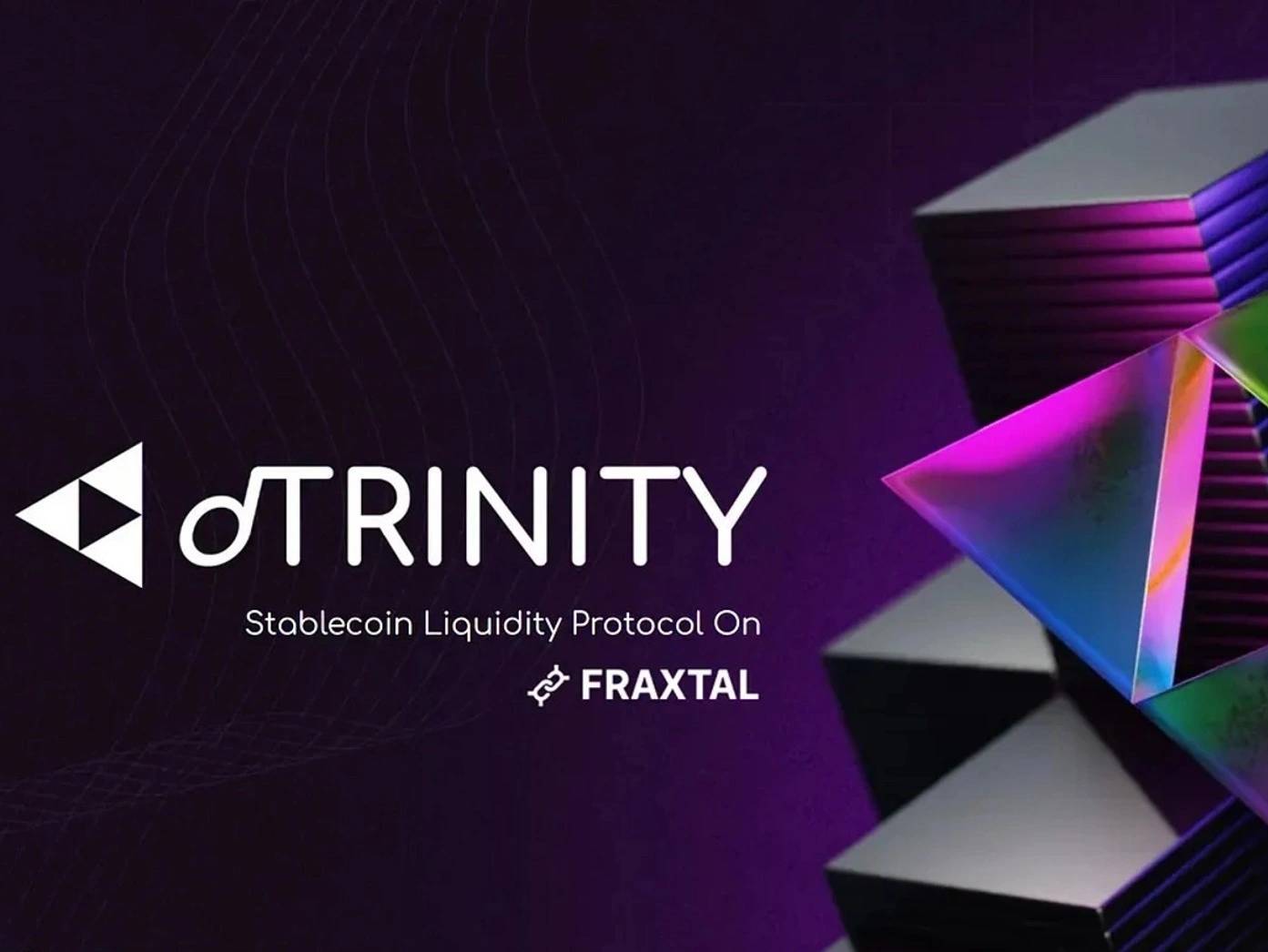위키 구독하기
Share wiki
Bookmark
dTRINITY
dTRINITY
dTRINITY는 대출 비용을 줄이고 지속 가능한 이자율을 제공하여 sFRAX, sUSDe, sDAI와 같은 수익률 자산의 루핑 전략을 개선하도록 설계된 스테이블코인 유동성 프로토콜입니다. [1]
개요
dTRINITY는 낮은 차입 비용, 지속 가능한 수익률, 그리고 새로운 이더리움 레이어 2 및 레이어 3 생태계에서 필수적인 DeFi 인프라를 제공하는 탈중앙화 유동성 프로토콜입니다. 2024년 3분기에 출시될 예정이며, 초기에는 네이티브 블록스페이스 인센티브를 제공하는 레이어 2 네트워크인 Fraxtal에서 운영될 것입니다. dTRINITY는 dUSD 스테이블코인, dLEND 머니 마켓, 그리고 dSWAP 거래소와 TRIN 거버넌스 토큰의 세 가지 핵심 구성 요소를 가지고 있습니다. dUSD는 Fraxtal L2 네트워크에서 커뮤니티 중심의 미국 달러 스테이블코인으로, USDC 또는 법정화폐 담보로 상환 가능하며, 온체인 거래 및 법정화폐 온/오프램프 활동을 가능하게 합니다. 담보 준비금의 수익은 차입자 이자율을 보조합니다. Aave v3의 포크인 dLEND는 dUSD 및 기타 디지털 자산의 담보 대출/차입을 지원하며, Uniswap v3의 포크인 dSWAP은 dUSD를 기본 통화쌍으로 효율적인 거래 및 담보 청산을 가능하게 합니다. [2]
Fraxtal
Fraxtal은 옵티미즘(Optimism) (OP) 스택 모듈형 롤업(rollup) 2계층(Layer 2) 블록체인으로 "프랙탈 스케일링"을 특징으로 합니다. EVM과 동등한 롤업(rollup)이며, 스마트 계약 플랫폼에 OP 스택을 사용하여 이더리움(Ethereum)의 롤업(rollup)인 옵티미즘(Optimism)이나 베이스(Base)와 유사하게 안전하고 비용 효율적인 애플리케이션 배포를 가능하게 합니다. 프랙탈(Fraxtal)은 모듈형으로, 다른 체인 및 네트워크를 위한 여러 구성 요소와 미들웨어를 통합하고 있으며, 현재는 프랙스(Frax) 코어 팀이 개발한 데이터 가용성 모듈을 사용합니다. 가스(gas) 사용 및 스마트 계약(smart contract) 상호 작용에 대해 사용자와 개발자에게 FXTL 포인트로 보상하는 블록 공간 인센티브(Flox)를 제공하며, 이는 토큰으로 전환 가능합니다. 기본 가스(gas) 토큰은 프랙스 파이낸스(Frax Finance)의 프랙스 이더(Frax Ether, frxETH)이며, 사용자와 dTRINITY와 같은 스마트 계약(smart contract)은 추가 인센티브로 FXTL 포인트를 얻을 수 있습니다. [3]
특징
dUSD 스테이블코인
dTRINITY USD (dUSD)는 체인 상의 USD 기반 스테이블코인 및 수익 생성 자산으로 뒷받침되는 탈중앙화된 전액 준비금 스테이블코인입니다. Fraxtal L2에서 발행되는 dUSD는 가스 비용을 제외하고는 수수료 없이 스마트 계약을 통해 담보를 유지합니다. 준비금 자산은 품질, 실적, 위험 프로필 등의 요소를 기반으로 선택되며, 최소 90%는 차입자에게 수익을 창출하는 yieldcoin에 할당됩니다. 가격 안정성은 기초 자산을 기반으로 자산 가치를 결정하는 API3 오라클을 사용하여 유지됩니다. 거버넌스는 준비금 자산 조정, 필요시 발행 중단, 유동성 변동으로 인한 디페깅 위험 완화를 통해 위험 관리를 감독합니다. [4]
유틸리티
dUSD는 dTRINITY의 기본 스테이블코인이자 통합된 유동성 계층으로, dLEND와 dSWAP 모두의 기본 통화쌍 역할을 합니다. 자체 준비금의 부유 수입을 외부화하지 않는 중앙화된 스테이블코인과 달리, dUSD는 프로토콜의 성장과 채택을 촉진하기 위해 부유 수입의 대부분을 이자율 보조금으로 dTRINITY 커뮤니티에 배분하는 것을 우선시합니다. [4]
이러한 접근 방식은 프로토콜의 성공이 dTRINITY와 dUSD가 계속 확장됨에 따라 커뮤니티 구성원에게 직접적으로 향상된 가치로 이어지는 커뮤니티 중심 모델을 강화합니다. [4]
안정성 유지 메커니즘
- 비상환성: dUSD는 준비금에 대한 직접 상환을 허용하지 않고, 대신 차입자, 거래자 및 유동성 제공자의 차익거래와 공개 시장 조작을 통해 탈중앙화 거래소에서 1달러에 대한 소프트 페그를 유지합니다.
- 안정성 시장 조작 (SMO): dUSD가 1달러 미만으로 거래될 때, 프로토콜은 거래소에서 토큰을 매입하여 공급을 줄이고 페그를 안정화합니다. 이 과정은 또한 차익거래 이익을 창출하여 초과 담보를 증가시킵니다.
- 알고리즘 시장 조작 (AMO): dUSD가 1달러를 초과하여 거래될 때, 프로토콜은 지정된 유동성 풀에 추가 토큰을 공급하여 공급을 확장하고 페그를 안정화하는 동시에 차익거래를 통해 준비금을 축적합니다.
- 차입자 차익거래: 차입자는 dUSD가 1달러 미만으로 거래될 때 할인된 가격으로 부채를 상환하고, 1달러에 차입하여 프리미엄에 매도하여 이익을 얻을 수 있습니다. 이러한 행위는 가격 안정성을 강화합니다.
- 시장 조성자 (MM) 차익거래: 시장 조성자는 할인된 가격으로 dUSD를 매입하거나 1달러에 주조하여 프리미엄에 매도함으로써 가격 변동을 이용하여 이익을 얻고, 유동성을 추가하고 프로토콜 중심 안정화 메커니즘에 대한 의존도를 줄입니다.
- 담보 비율 (CR): 프로토콜 운영으로 인한 초과 준비금은 dUSD의 담보 비율을 100% 이상으로 높여 신뢰도를 강화하고, 가격 변동을 안정화하며, 준비금 평가절하에 대한 완충 역할을 합니다. 거버넌스는 임계값을 초과할 때 초과 준비금을 어떻게 배분할지 결정할 수 있습니다. [4]

동적 이자
dUSD는 매주 예비금 수익의 90% 이상을 사용하여 차입 비용을 보조하고, 미상환 부채를 기준으로 차입자에게 리베이트로 배포하며 새로운 토큰을 발행합니다(민팅, https://iq.wiki/wiki/minting). 리베이트 비율은 예비금 수익률과 유통되는 dUSD 대비 총 부채 비율에 따라 달라집니다. 또한, dUSD는 여러 번 재대출될 수 있으며, 이는 전통적인 은행 시스템과 유사하게 승수 효과를 창출하여 총 차입 및 공급 가치가 기본 통화 공급량을 초과할 수 있습니다. [4]
금리 사이클
dUSD의 금리 사이클은 시장 수요와 공급에 따라 대출 금리가 동적으로 조정되므로 기존 연준 사이클과 반대로 작동합니다. 대출 수요가 낮으면 금리가 하락하여 부채 발행이 증가하고 안정성 시장 운영(SMO)을 통해 dUSD 공급이 감소합니다. 반대로 대출 수요가 증가하면 금리가 상승하여 대출자가 더 많은 dUSD를 공급하고 차입자가 대출을 상환함으로써 알고리즘 시장 운영(AMO)을 통해 dUSD 공급이 확대됩니다. 프로토콜은 차입자에게 보조금을 지급하여 대출자의 인센티브를 매력적으로 유지하고 지속적인 생태계 참여를 촉진함으로써 활용률을 유지합니다. [4]

dLEND 머니 마켓
dLEND는 Fraxtal의 Aave V3를 포크한 담보 대출 시장으로, 사용자는 자신의 담보물을 통해 대출을 받고, 지속적인 이자 지급을 받는 대가로 차용자에게 유동성을 제공할 수 있습니다. 레버리지, 공매도, 헤징을 포함한 다양한 금융 전략을 지원하며, 수익률 루핑 전략에 중점을 둡니다. [5]
이 프로토콜은 Fraxtal에서 dUSD 및 기타 디지털 자산의 담보 대출 및 차용을 가능하게 합니다. dLEND의 dUSD 차용 금리는 수요와 활용도를 높이기 위해 정기적으로 보조금을 받아, 다른 프로토콜 및 네트워크 인센티브와 함께 dUSD 대출자에게 지속 가능한 스테이블코인 수익률을 창출합니다. [5]
dLEND에서 대출자는 차용자가 대출금을 사용할 때 대출 자본에 대한 이자를 얻으며, 종종 대출자가 얻는 것보다 더 높은 APR을 지불하는 대출로 이어집니다. 대출 및 차용에 대한 이자율은 활용률에 따라 결정되며, 더 높은 금리는 차용자가 대출금을 상환하도록 유도하고 더 많은 대출자를 유치하여 새로운 차용자를 위한 유동성을 확보합니다. [5]
차입 보조금
dUSD 차입은 보조금 혜택을 받아 담보에 비해 가장 비용 효율적인 옵션입니다. dLEND의 프로젝트는 대출자 또는 차입자에게 추가 토큰으로 보상함으로써 사용률을 더욱 높일 수 있습니다. dTRINITY의 거버넌스는 현재 시장에 새로운 보상 토큰을 도입하여 사용자 참여를 유도할 수 있습니다. 이러한 보조금으로 인해 dUSD의 차입 APR이 공급 APY보다 낮아질 수 있으며, 이는 비보조금 시장보다 높은 이용률로 이어질 수 있습니다. [5]
dUSD 시장
dUSD는 dLEND에서 차용하기 위한 지정된 스테이블코인으로, 차용자는 스테이블코인을 바꾸지 않고도 일관되고 낮은 차용 비용을 누릴 수 있습니다. 이는 차용 절차를 간소화하고, 지속적인 차용자 보조금으로 인해 대출자는 지속적인 이용률과 더 높은 수익률을 얻을 수 있도록 합니다. [5]
오라클
dLEND는 시장 상황에 따라 혼합 오라클(oracle) 접근 방식을 사용합니다. 주로 광범위한 외부 가격 발견 시장이 있는 자산에 대해 RedStone Oracles(레드스톤 오라클)에 의존합니다. Fraxtal(프랙탈)에만 독점적인 자산이거나 외부 시장에서 유동성이 부족한 자산의 경우 dSWAP이 가격 오라클(오라클) 역할을 합니다. RedStone(레드스톤) 가격이 오래된 경우 dSWAP은 대체 오라클(오라클)로도 작동합니다. [5]
청산
dLEND의 차용자는 대출가치비율(LTV)이 시장에 따라 다르지만 특정 임계값 이하로 떨어지면 청산될 위험에 직면합니다. 청산을 피하려면 차용자는 담보를 더 추가하거나 부채의 일부를 상환할 수 있습니다. 청산이 발생하면 청산인과 프로토콜 모두 수수료를 부과하며, 그 금액은 관련 시장에 따라 다릅니다. [5]
DeFi FlyWheel
dTRINITY의 FlyWheel은 외생적 및 내생적 인센티브를 통해 유동성과 사용자 활동을 유치하고 TVL 성장과 함께 지속 가능하게 확장되도록 설계되었습니다. 이 프로토콜은 거버넌스 토큰 보유자와 공급측 참여자, 예를 들어 dUSD 유동성을 제공하는 대출자 및 LP 간의 상호 작용을 강화하기 위해 ve(3,3) 프레임워크를 통합합니다. [6] [7]
외생적 인센티브에는 dUSD 보상 및 보조금, FXTL 네트워크 보상 및 생태계 파트너의 인센티브가 포함됩니다. 내생적 인센티브에는 TRIN 토큰/포인트 보상 및 TGE 이후 투표 에스크로된 TRIN(veTRIN) 토큰 보유자와의 프로토콜 수수료 공유가 포함됩니다. [6]

파트너십
- 스테이블리(Stably)
- 프랙스(Frax)
- 프랙탈(Fraxtal)
- 크림 랩스(Cream Labs)
- 코인98(Coin98)
- 베리체인스(Verichains)
- 레드스톤 오라클(RedStone Oracles) [8]
잘못된 내용이 있나요?
